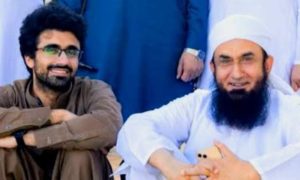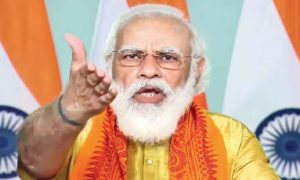Even after being separated and confined to the two divided parts of Kashmir due to the 1947 Indo-Pak War, two Rajouri sisters never lost hope to meet each other one day. As they finally came face-to-face, the world around them had changed, so had the siblings, separated seventy years ago.
As laptops across the ‘border’ began beaming the much-awaited visuals, two skinny grandmothers appeared on the screen. Around those fragile figures, teary eyes twinkled over the meeting of the two siblings, lost in that tragic fall of 1947.
For the moment, time froze between them.
“Why has your hair grayed?” the ninety-something sister from Pakistan-Administrated Kashmir’s Mirpur sporting jet black hair asked her sibling.
On the other side of the screen, in Rajouri, her grayed sibling could only flash a toothless smile.
And then, both of them cried, in longing of the good old days, over the demise of their family members, their lost bachpan and most importantly over the brute borders that prevented their reunion for over seventy years.

Fatima talking to her sister Kesaro, seen on laptop screen.
“Kesaro,” says Ghulam Fatima, the elder sibling from Mirpur, “you were just two years old when I slapped you and Roti fell from your mouth.”
Smiles beam on their parched faces. Apparently in pain and pining spanned over seventy years, they let out a stream of tears from their sunken eyes.
“Mother scolded me for this,” Fatima continues, as her sibling, Kesaro Devi continuously smiles and giggles like a baby. “You were so chubby with red cheeks. Though I remember few things…”
Before this moment of reunion, almost eons had passed between the siblings who lost touch with each other after violence engulfed the north of Indian subcontinent during the 1947 Partition.
ALSO READ: JammuMassacre@70: The lady who averted the post-pogrom crisis
Much of that had to do with the unjustified boundary and border drawn by Cyril Radcliffe, owing to his ignorance of Indian affairs, as claimed by Alastair Lamb in his book Kashmir: A Disputed Legacy.
Following the border barbarity, the revolt in the erstwhile princely state of Jammu and Kashmir sealed the fate of the two sisters, oblivious of the political storm shaping around them.
In that fall of 1947, the common masses of the state had first erupted with the famous Poonch Rebellion against the oppression of Maharaja Hari Singh’s regime.
Led by Sardar Ibrahim Khan who later came to be known as the ‘Father of Kashmir’, the Poonch Rebellion was completely indigenous in nature. Being a member of the Muslim Conference, Khan took the charge of the party from acting President of Muslim Conference, Choudhary Hamidullah before the start of the rebellion.

Sardar Ibrahim Khan
Due to growing oppression in the state, the Tribals came and clashed with the Dogra forces, reportedly supported by RSS volunteers.
“In spite of all this,” Sardar Ibrahim Khan writes in his book, The Kashmir Saga, “since 27 Oct 1947, the Azad Army was able to conquer from Indian army practically the whole of Poonch, with the exception of Poonch city. The whole of Rajouri and Mirpur districts right down to Akhnoor were captured by us.”
It was under such circumstances that Satya Devi, who later became Ghulam Fatima, got separated from her family in Rajouri. She was displaced to Mirpur unknowingly.
“I do not remember many things,” says Fatima. “I remember that a siren was blown and it was a chaotic, a war-like situation. I had been married six months ago. It was a horrible situation. I had no dupatta on my head. Nothing, but clothes which I had on my body.” In that war, she even lost the address of her groom.
But before the historic shift would push her to Mirpur, Fatima was born as Satya to Lakshman Das and Karam Nora in Rajouri’s Chingas area. Among her two sisters and two brothers, only Kesaro Devi, her youngest sister, survived. She is now living with her son, Rakesh Sharma, in Rajouri.

Kesaro Devi
Fatima still remembers the day when she reached Mirpur with a multitude of grieving faces—crying their hearts out over the unfathomable borders, lost families and political constraints.
Those were overwhelming scenes, she recalls, when people were losing their old identities and assuming new ones, for the sake of survival.
She soon found herself taking refuge in one of Mirpur’s Muhajir camps.
“The Azad Kashmir government had numerous difficulties, but it certainly did its best to organize the camps for non-Muslims,” Sardar Ibrahim Khan, while commenting upon the situation of Muhajir camps, writes in his book. “Some of the camps existed for 3 to 4 years. One camp at Muzaffarabad existed as late as 1950-51.”
As time passed and despair to revisit her roots deepened, the fellow migrants convinced her to get married and restart her life.
Before she would even consider the suggestion, territories of Jammu & Kashmir including Rajouri were recaptured by 19 Infantry Brigade of Indian Army on 12 April 1948, under the command of Rama Raghoba Rane.
ALSO READ: JammuMassacre@70: The tale of two migrations
Even then, there seemed no possibility for Fatima to go back to Rajouri and live with her family.
“It seemed that war would never end,” she recalls, musing and mulling over her turbulent life period. “I got convinced and accepted a marriage proposal of Raja Painda Khan who was a government employee. It was not by force but situation was such that I took the decision out of my own will. There seemed no chance of going back.”
Back then, a provisional government was formed with its capital at Pulandari, a small town near Poonch. Sardar Ibrahim Khan who led the Poonch Rebellion was elected as President.
Reflecting upon the local support and a just system that was established, Sardar Ibrahim Khan writes in his book, “I can state without contradiction that during 1947-48 and 49, dacoit and murder cases were one in thousand.”
It was this internal peaceful and conducive atmosphere that encouraged Fatima to take the most important decision of her life.

Fatima
It was not a shock for her to switch to Islamic teachings, she says, as in Rajouri, people of different faiths including Muslims used to live in ‘harmony’. So, she knew the customs.
“I was familiar with Islam,” she says. “We were Brahmins and ate halal food and used to practice circumcision. Muslims living in our neighborhood were very good. So, it was not such a difficult thing to accommodate my life according to Muslim norms.”
Though Rajouri falls in Pir Panjal region, it has always been very close to Kashmir Valley religiously, culturally, politically. Even Christopher Snedden in his famous book, The Untold Story of People of Azad Kashmir, confirms this communal harmony and tolerance.
“Certainly,” he writes, “Kashmiriness and secular thinking of Kashmiris were significant reasons why the Kashmir Valley experienced almost no communal violence during 1947. Kashmiris were more tolerant, their practice of Islam and Hinduism more liberal, and their inter-communal relationships more involved and harmonious than those in other parts of the princely state.”
ALSO READ: JammuMassacre@70: What it meant to be a Muslim woman in Jammu in 1947
After losing track of their daughter for almost forty years, the family of Satya in Rajouri, now living as Fatima in Mirpur, finally came to know of her whereabouts.
“In 1985, we came to know by some people who had relatives in Pakistan that our sister is in Mirpur,” says Kesaro Devi. “We contacted her through letters and cassettes. Haq Nawaz, Fatima’s son-in-law kept both the families in touch.” But soon as insurgency against Indian State erupted in Kashmir, the exchange of letters stopped in 1989.
And then one day, amid frequent frontier flare-ups in Rajouri, a local Sarpanch informed Kesaro Devi’s family that their sister in Pakistan has breathed her last.
“The only memory left for us was her letters,” Kesaro says. “We used to look at those letters and cry bitterly. Upon seeing our painful situation our children hide those letters from us. With time we lost all those letters.”
It was not until this fake news shocked and consumed their brother Shamshad Chand that the family learned that Fatima was very much alive.
Back in Mirpur, the elder sibling was in bad health and would often tell her grandchildren that she would only die after talking to her relatives in Rajouri.
If you get me in touch with my relatives in Rajouri, she would implore them, Allah will reward you equal to Hajj.
“It was a long search,” says Misbah Nawaz, Fatima’s granddaughter. “I asked a friend, who happened to have relatives in the other side of Kashmir. She contacted her relatives and did everything to get us the details and contacts from Rajouri.”
Finally, the seventy-year long wait ended with a video call on 27 April 2018. The virtual meeting was all about tears.
Fatima’s religion was more than acceptable for Kesaro’s family, as they believe that religion hardly matters in the circumstances she faced.
“It was all written by God,” says Kesaro Devi, about her now Muslim sister. “May God bless our children, who facilitated our meeting!”
Like this story? Producing quality journalism costs. Make a Donation & help keep our work going.












